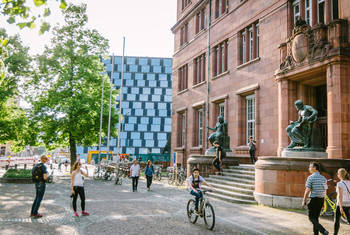Stephan Packard How Does the Depiction of Cartoon Characters’ Bodies and Faces Influence Our Reaction to Them?
Stephan Packard is Junior Professor for Media and Culture Studies at the Albert-Ludwigs-University, Freiburg (Germany). In 2015, Packard was awarded the Heinz Maier-Leibnitz Prize of the German Research Foundation. In his research, Packard focuses on topics such as censorship, semiology, and control across various mediums and cultures. Particularly, Packard examines tools of communication and representation in cartoons.
Area of Research
Media Semiotics, Media Archeology, Comics Studies, Censorship and Media Control, Transmedia Naratology, Media and Politics
since 2015
Substitute Professor for Theories and Cultures of the Popular
University of Cologne (Universität zu Köln)
Institute for Media Culture and Theatre
2010-2015
Junior Professor for Media Culture Studies
Albert Ludwigs University of Freiburg (Albert-Ludwigs-Universität Freiburg) (more details)
2004-2010
Assistant Professor for Comparative Literature
Ludwig Maximilian University Munich (Ludwig-Maximilians-Universität München)
2004
PhD in Comparative Literature
Ludwig Maximilian University Munich (Ludwig-Maximilians-Universität München)
Thesis "Psychosemiotische Comicanalyse"
2004
Master in German Literature, Comparative Literature and Philosophy
Ludwig Maximilian University Munich (Ludwig-Maximilians-Universität München)
Prizes
- Award "Gute Lehre" (Great Teaching) at Universität zu Köln (2015)
- Heinz Maier-Leibnitz-Preis of the German Research Foundation DFG and the Federal Ministry of Education and Research (2015)
Fellowships
- Scholarship from the Bayerische Begabtenförderung (1999-2004)
 © Sandra Meyndt/University of Freiburg
© Sandra Meyndt/University of Freiburg

Albert Ludwigs University of Freiburg (Albert-Ludwigs-Universität Freiburg)
Founded in the 15th century, the University of Freiburg has a long-standing reputation of excellence in academic teaching and research. Among the most renowned university members were the philosophers Edmund Husserl and Martin Heidegger, the economist Walter Eucken, and such Nobel Prize winners as Hans Spemann, Hermann Staudinger, Georg von Hevesy, Friedrich August von Hayek and George Köhler. Today, with its mixture of traditional subjects and modern technology, the University of Freiburg is flourishing more than ever. The university and its hospital employ more than 19,000 staff members. Organized according to the classical model of a comprehensive university, it provides 25,000 students with a broad range of subjects – from applied information technology, the entire spectrum of medical specialities and natural sciences to the fields of humanities and social sciences. Freiburg’s research and teaching policies aim to overcome the barriers between individual disciplines to create opportunities for new perspectives on complex problems. By supporting collaborative research projects across boundaries and implementing centers of knowledge and interdisciplinary graduate colleges, the university provides the disciplines an effective means by which to benefit from each other’s knowledge.
An added benefit that comes with such flexibility is an increased international interest for our university: We are pleased to have a significant number of scientists and students from all over the world, whose culture-specific views of scientific procedures and research approaches enrich the dialog with their German counterparts. 16% of the student body are from foreign countries. The general international exchange of scientific results and experiences also plays an important role at the University of Freiburg. More than 300 partner universities and programs on five continents, together with the alumni association, form a first-class international network. (Source: University of Freiburg)
Map
As STEPHAN PACKARD explains, readers’ interpretation of cartoon characters is strongly influenced by the way they are depicted. Characters in comic books are often drawn in a very reduced way, and show both human and animal-like features. In the semiotic analysis presented in this video the relation between the way characters are depicted and the readers’ reaction is examined. An important finding is that the readers’ willingness to recognize human features is strongest when there is an emphasis of facial aspects used for communication, e.g., eyes and mouth.
LT Video Publication DOI: https://doi.org/10.21036/LTPUB10114
Was ist ein Cartoon? Psychosemiotische Überlegungen im Anschluss an Scott McCloud
- Stephan Packard
- Published in 2009









